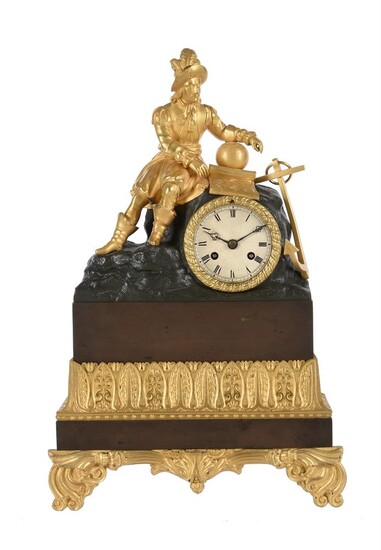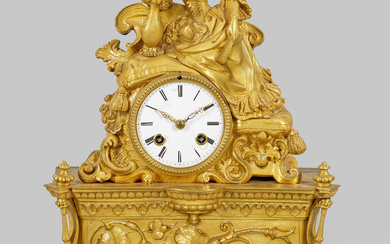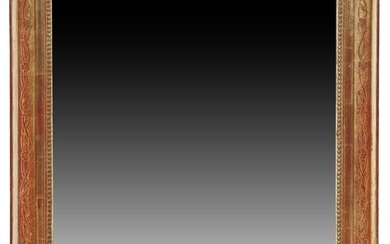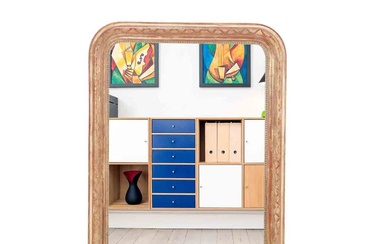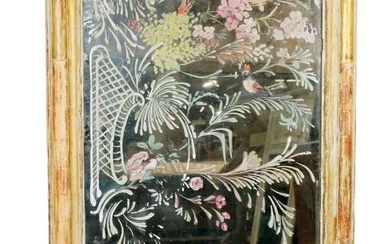A FRENCH LOUIS PHILIPPE GILT AND PATINATED BRONZE FIGURAL MANTEL CLOCK
A FRENCH LOUIS PHILIPPE GILT AND PATINATED BRONZE FIGURAL MANTEL CLOCKPons, Paris, circa 1840The eight-day two train countwheel bell striking movement with anchor escapement regulated by disc bob pendulum incorporating silk suspension and stamped with Pons, MEDAILLE D'OR, 1827 roundel over serial number 2131 to backplate, the circular silvered Roman numeral dial with blued steel trefoil hands within rope-twist cast surround, the case modelled with a 17th century mariner resting on a rocky outcrop with globe, anchor and a chart over plinth base incorporating generous gilt repeating leaf cast decoration to skirt and anthemion cast feet.43cm (17ins) high, 28cm (11ins) wide, 10cm (4ins) deep. Pierre-Honoré-César Pons was born in Paris in 1773 and after studying with the Jesuits in the rue Mouffetard he went to train under the eminent clockmaker Antide Janvier. Unfortunately the unrest of the French Revolutionary period disrupted his training but he was recommended by Janvier to the prestigious Lepaute family who took him on in 1798. Pons completed his training under the Lepautes and developed an interest in precision horology; in 1803 he opened his own workshop rue de la Huchette, near the Place Saint-Michel. In order to satisfy the financial demands of running a workshop, whilst taking time to work on the development of precision horology, Pons acted as supplier of movements to many the eminent horologists of the period such as Berthoud, Breguet and Lepine. During this time he developed several escapements and created improved wheel-cutting and pinion polishing machines. With the encouragement of Ferdinand Berthoud in 1804 Pons presented his 'Observations sur l'échappement libre' to the Academy of Sciences where it was praised by the jury and the Academy congratulated him. Around this time the French clockmaking town of Saint-Nicholas d'Aliermont was in crisis due to the collapse of the industry. Napoleon's minister responsible for Fine Arts, Industry and Commerce, the Count de Champagny, ordered the Académie des Sciences to find someone suitable to turn the industry around. Honoré Pons was approached as he had the necessary skills and had developed the tools and practices most appropriate for the task. After a period of reluctance he accepted on the basis that the state will pay him a generous amount for his machines as long as they were installed and used in the Saint Nicholas workshops. By 1808 Pons was producing fine quality 'blanc-roulants' for an affordable price which received high praise from makers such as Breguet and recognition by the Academie in their report to Napoleon Bonaparte.Over the following decades Honoré Pons expanded the Saint Nicholas operations and became a principal supplied of movements to the Parisian clockmaking trade from his premises in Paris's rue de la Barillerie on the île de la Cité. In 1827 he was awarded a gold medal and in 1839 was awarded the Croix de la Légion d'Honneur by King Louis Philippe. In 1846, at the end of an illustrious career, pons sold his firm to Borromée Délépine and retired, living in an elegant Parisian mansion at 20, rue Cassette.
[ translate ]Estimate
Time, Location
Auction House
A FRENCH LOUIS PHILIPPE GILT AND PATINATED BRONZE FIGURAL MANTEL CLOCKPons, Paris, circa 1840The eight-day two train countwheel bell striking movement with anchor escapement regulated by disc bob pendulum incorporating silk suspension and stamped with Pons, MEDAILLE D'OR, 1827 roundel over serial number 2131 to backplate, the circular silvered Roman numeral dial with blued steel trefoil hands within rope-twist cast surround, the case modelled with a 17th century mariner resting on a rocky outcrop with globe, anchor and a chart over plinth base incorporating generous gilt repeating leaf cast decoration to skirt and anthemion cast feet.43cm (17ins) high, 28cm (11ins) wide, 10cm (4ins) deep. Pierre-Honoré-César Pons was born in Paris in 1773 and after studying with the Jesuits in the rue Mouffetard he went to train under the eminent clockmaker Antide Janvier. Unfortunately the unrest of the French Revolutionary period disrupted his training but he was recommended by Janvier to the prestigious Lepaute family who took him on in 1798. Pons completed his training under the Lepautes and developed an interest in precision horology; in 1803 he opened his own workshop rue de la Huchette, near the Place Saint-Michel. In order to satisfy the financial demands of running a workshop, whilst taking time to work on the development of precision horology, Pons acted as supplier of movements to many the eminent horologists of the period such as Berthoud, Breguet and Lepine. During this time he developed several escapements and created improved wheel-cutting and pinion polishing machines. With the encouragement of Ferdinand Berthoud in 1804 Pons presented his 'Observations sur l'échappement libre' to the Academy of Sciences where it was praised by the jury and the Academy congratulated him. Around this time the French clockmaking town of Saint-Nicholas d'Aliermont was in crisis due to the collapse of the industry. Napoleon's minister responsible for Fine Arts, Industry and Commerce, the Count de Champagny, ordered the Académie des Sciences to find someone suitable to turn the industry around. Honoré Pons was approached as he had the necessary skills and had developed the tools and practices most appropriate for the task. After a period of reluctance he accepted on the basis that the state will pay him a generous amount for his machines as long as they were installed and used in the Saint Nicholas workshops. By 1808 Pons was producing fine quality 'blanc-roulants' for an affordable price which received high praise from makers such as Breguet and recognition by the Academie in their report to Napoleon Bonaparte.Over the following decades Honoré Pons expanded the Saint Nicholas operations and became a principal supplied of movements to the Parisian clockmaking trade from his premises in Paris's rue de la Barillerie on the île de la Cité. In 1827 he was awarded a gold medal and in 1839 was awarded the Croix de la Légion d'Honneur by King Louis Philippe. In 1846, at the end of an illustrious career, pons sold his firm to Borromée Délépine and retired, living in an elegant Parisian mansion at 20, rue Cassette.
[ translate ]